In recent years, there has been a rise in the popularity of alternative methods of heating homes, particularly with the growing concerns over the environmental impact of fossil fuels. Two popular options for home heating are wood burning stoves and gas stoves. While both provide warmth and comfort to a household, they differ significantly in terms of fuel type, cost, and maintenance. As such, a common question arises, wood burning stove vs gas stove: which is the better choice?
In this article, we will delve into the key differences between these two stoves, their pros and cons, and ultimately determine which option is better. Whether you are looking for a primary or supplemental heat source, this comparison between wood burning stoves and gas stoves will help you make an informed decision and choose the best stove for your home. So, let's explore the world of stoves and find out which one comes out on top in the battle of Wood Burning Stove vs Gas Stoves.
How do Wood Burning Stoves work?
Wood burning stoves are marvels of engineering that efficiently convert wood into heat for your home. Understanding their inner workings can help you appreciate their functionality and make informed decisions when choosing one for your living space. At the heart of a wood burning stove lies the combustion chamber. This chamber is where the magic happens. Here's a step-by-step breakdown of how it all works:
- Fuel Loading: It all starts with loading the stove with seasoned wood. Seasoned wood has a lower moisture content, making it ideal for burning efficiently.
- Air Intake: To ignite the fire, you need a supply of oxygen. Most wood stoves have adjustable air vents or dampers to control the air intake. More air means a hotter, faster-burning fire.
- Ignition: When you light the wood, it begins to burn, producing flames and heat. Volatile gases released from the wood are what initially fuel the fire.
- Heat Transfer: The heat generated in the combustion chamber is transferred to the stove's body, typically made of cast iron or steel. The stove's body is a heat exchanger, warming up the metal. Radiant heat is then emitted from the stove's surface, warming the surrounding area.
- Chimney and Exhaust: Smoke and gases produced during combustion are carried away through the chimney. Proper chimney design and insulation ensure exhaust gases exit the home safely and without creating drafts.
- Ash Production: As the wood burns, it leaves behind ashes. These ashes need to be regularly removed to maintain the stove's efficiency.
Types of Wood Burning Stoves
Wood burning stoves come in a variety of designs, each with its unique features and advantages. Choosing the right type of wood stove is crucial to ensure that it meets your heating needs and complements your home's aesthetics. Let's explore the different wood burning stove types to help you make an informed choice for your home.
Freestanding Wood Burning Stove
The freestanding wood burning stove embodies the quintessential image of a cozy, fireside retreat. These stoves are designed to stand independently, making them versatile in placement within your home. One of their standout features is their capacity to accommodate larger logs, allowing for extended burn times. It provides a steady heat source and reduces the need for frequent refuelling.
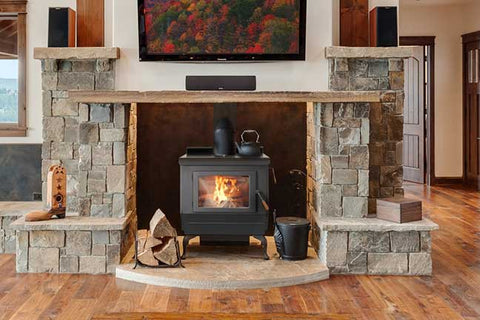
Freestanding wood stoves come in a wide range of sizes, finishes, and designs, ensuring you can find one that perfectly complements your interior decor. Whether you're looking to create a rustic, traditional ambiance or a more contemporary feel, the freestanding wood burning stove is a timeless choice that most efficient wood burning stove in the world.
Cast Iron Wood Stove
Cast iron wood stoves are renowned for their remarkable durability and exceptional heat retention capabilities. The cast iron construction ensures longevity and allows the stove to radiate heat even after the fire has subsided. These stoves often feature intricate and elegant designs, making them functional and aesthetically pleasing.
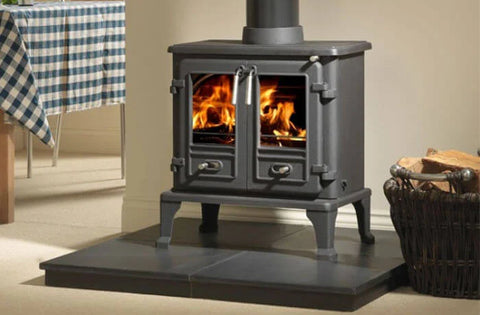
The combination of form and function is a hallmark of cast iron wood stoves, making them a favorite among homeowners who appreciate both the practicality of efficient heating and the timeless charm of a beautifully crafted piece. Whether nestled in a rustic cabin or a modern home, this is best indoor wood burning stove to your living space.
Modern Wood Burning Stove
Modern wood burning stoves represent a fusion of cutting-edge technology and sleek design. Clean lines, minimalist aesthetics, and advanced combustion mechanisms characterize these stoves. They excel in efficiency, emitting minimal emissions while maximizing heat production. This eco-friendly approach makes them a responsible choice for those who prioritize environmental concerns.

Modern wood stoves are designed to be efficient and easy to use, often featuring user-friendly controls for precise temperature regulation. They are ideal for contemporary living spaces, where they can serve as a focal point, combining both style and functionality. If you seek a wood burning stove that embodies the best of modern engineering and design while providing efficient, clean, and visually appealing heating, it is an affordable wood burning stoves.
Non-Catalytic Wood Stoves
Non-catalytic wood stoves utilize innovative secondary combustion technology for cleaner emissions and improved efficiency. These stoves are known for their ease of use and maintenance. Unlike catalytic stoves, they do not require a catalytic combustor, simplifying the operation.
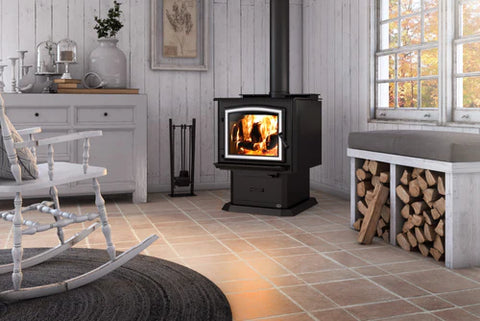
Non-catalytic stoves offer consistent heat output and are less dependent on the type of wood used, making them suitable for a wide range of users. Their efficient burning process ensures minimal wasted energy, translating into cost savings for homeowners. Whether you are new to wood burning stoves or a seasoned user, non-catalytic wood stoves provide a hassle-free and efficient heating solution.
Small Modern Wood Stoves
Small Modern Wood Stoves are designed for those with limited space who still desire a wood-burning stove's warmth and charm. These compact stoves are perfect for small rooms, cabins, or even tiny homes. Despite their size, they retain the efficiency and eco-friendliness of their larger counterparts.

Small modern wood stoves often feature innovative designs, including space-saving features such as integrated storage for firewood. They are efficient in heating small spaces and can be positioned in areas where larger stoves might not fit. If you want to add warmth and style to a cozy living area or a compact living space, this eco friendly wood burning stove offers a practical and elegant heating solution.
Benefits of Using Wood Burning Stoves
Wood burning stoves have been a traditional source of heating for centuries. Despite the availability of modern heating options, they continue to be a popular choice for many homeowners. Let's explore the numerous advantages they offer:
Cost-Effective Heating
Wood is often more affordable than other heating fuels, making wood burning stoves a cost-effective option in regions with easy access to firewood. It can result in significant savings on heating bills during the colder months.
Environmentally Friendly
Wood is considered a renewable and carbon-neutral energy source when harvested sustainably. Wood stoves produce fewer greenhouse gas emissions when burned efficiently than fossil fuels, contributing to a more eco-friendly home heating solution.
Independence from Utility Companies
You are using a wood burning stove grants you independence from utility companies. You're not reliant on gas or electricity, which can be especially advantageous during power outages or when living in remote areas.
Ambiance and Aesthetics
One of the most appealing aspects of wood burning stoves is the cozy and rustic ambiance they create. The sight and sound of crackling wood logs and the warmth radiating from the stove contribute to a comfortable and inviting atmosphere in your home.
Emergency Heating
Wood stoves can serve as a reliable source of emergency heating. In extreme weather conditions or heating system failures, you can keep your home warm using your wood stove. It is a valuable asset for ensuring the safety and comfort of your family.
How do Gas Stoves Work?
Gas stoves are a marvel of engineering, offering a reliable and efficient way to cook food and heat homes. It operate on the principle of controlled combustion. Here's a detailed breakdown of their functioning:
Gas Supply
The heart of a gas stove system is the gas supply. Most gas stoves use either natural gas or propane as their fuel source. Natural gas is a common choice for homes connected to a gas utility, while propane is often used in areas without a natural gas supply. The gas is supplied to the stove through a series of pipes or a gas line.
Burners
Gas stoves typically have multiple burners, each with its control knob. These burners are responsible for producing the flames that heat your cookware. When you turn the knob for a specific burner, it opens a valve, allowing gas to flow to that burner.
Ignition
To start the combustion process, gas stoves use an ignition system. There are two main types of ignition:
- Pilot Light:In older models, a continuously burning pilot light provides the flame needed to ignite the gas when you turn on a burner. While reliable, pilot lights consume a small amount of gas even when the stove is not in use.
- Electric Ignition:Modern gas stoves often feature electric ignition systems. When you turn the knob to the "light" position, an electric spark is generated near the burner, igniting the gas. This system is more energy-efficient and eliminates the need for a pilot light.
Combustion
Once the gas is ignited, it combines with oxygen from the air to produce a controlled flame. The size of the flame can be adjusted using the burner control knobs, allowing you to regulate the heat output. When you turn the knob higher, more gas is released, resulting in a larger flame and more heat.
Heat Transfer
The flames generated by the burners heat the cooking surface, which, in turn, transfers heat to your cookware. This direct heat transfer is highly efficient, allowing precise cooking temperature control. Gas stoves are known for quickly adjusting from high heat to a low simmer.
Safety Features
Modern gas stoves are equipped with safety features to ensure safe operation. These may include:
- Flame Failure Device (FFD):If the flame is accidentally extinguished (e.g., due to a gust of wind), the FFD shuts off the gas supply to prevent leaks.
- Thermocouples:These sensors monitor the temperature of the burner. If the flame goes out, the thermocouple signals the gas valve to shut off the gas flow.
- Child Locks:Some stoves have child locks to prevent accidental knob turns.
Types of Gas Stoves
Gas stoves are ingenious appliances that provide efficient cooking capabilities for millions of households worldwide. Let's explore the various types of gas stoves, each with its characteristics and advantages.
Ventless Gas Stove
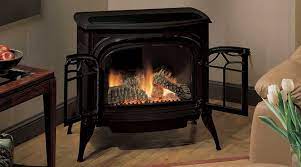
Ventless gas stoves, or vent-free gas stoves, are designed to operate without a chimney or venting system. They are highly efficient in heat output because they don't lose heat through a vent. Ventless gas stoves use a catalytic converter to clean and recirculate the air, making them suitable for homes without traditional chimney setups. However, they do require proper ventilation to ensure indoor air quality.
Direct Vent Gas Stoves
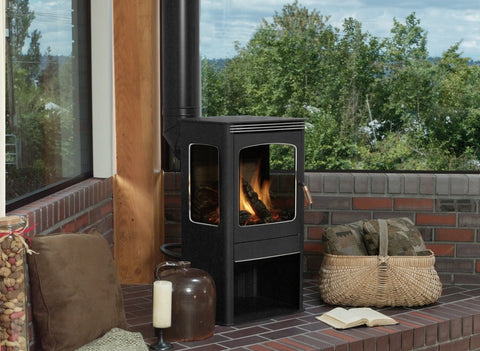
Direct vent gas stoves are popular for homeowners who want the look and feel of a traditional wood-burning stove but with the convenience of gas. These stoves have a sealed combustion system that draws in outside air for combustion and expels exhaust gases through a dedicated vent pipe. This design minimizes the impact on indoor air quality and ensures safety. Direct vent gas stoves offer efficiency and are available in various styles to match your home's decor.
Freestanding Gas Stoves
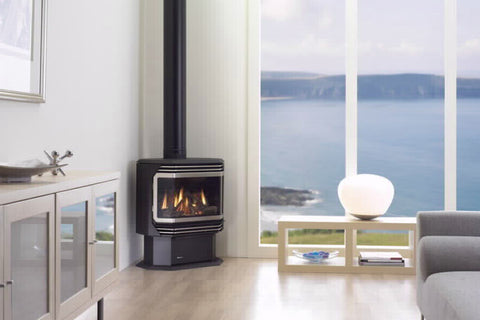
Freestanding gas stoves are versatile and can be placed anywhere in your home with a gas line and proper ventilation. They come in various sizes and designs, from classic to modern, allowing you to find a stove that complements your interior aesthetics. Freestanding gas stoves offer convenience and can be a focal point in any room.
Modern & Contemporary Gas Stoves
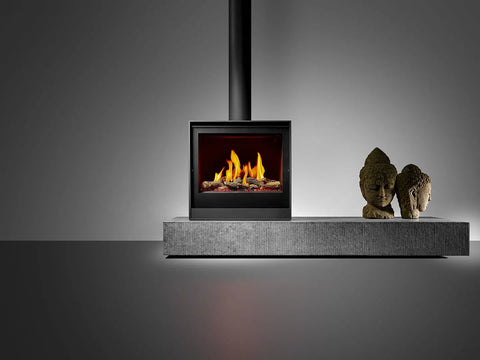
Modern gas stoves are an excellent choice for those who prefer sleek and contemporary design. These stoves often feature clean lines, glass viewing windows, and innovative technology. They can add a touch of elegance and sophistication to your living space while providing efficient heating. Modern gas stoves are known for their user-friendly controls and advanced safety features.
Buck Ventless Gas Stoves

Buck ventless gas stoves are a specific type of ventless gas stove known for their reliability and craftsmanship. These stoves are designed to mimic the appearance of a traditional wood-burning stove, complete with realistic logs and flames. Buck ventless gas stoves are known for their high heat output and are often used as a supplemental or primary heat source in smaller spaces.
Benefits of Using Wood Burning Stoves
Gas stoves offer several compelling benefits that make them a top choice for many homeowners. Here are the key advantages of using gas stoves:
Rapid and Precise Heating
One of the standout advantages of gas stoves is their ability to provide instant and precise heat. When you turn on a gas burner, it ignites immediately, allowing you to start cooking without delay. This rapid heating is beneficial when you need to boil water quickly or adjust the temperature with precision for delicate dishes.
Energy Efficiency
Gas stoves are known for their energy efficiency. They convert a high percentage of the gas into heat, minimizing waste. This efficiency saves you money on your gas bills and reduces your carbon footprint, making gas stoves an eco-friendly choice.
Even Cooking Temperature
Gas burners distribute heat evenly across the base of your cookware. This even distribution ensures that your food cooks uniformly, reducing the likelihood of hot spots or unevenly cooked dishes. Whether simmering a sauce or searing a steak, a gas stove can help you achieve consistent results.
Precise Control
Gas stoves provide excellent control over cooking temperatures. The knobs allow you to adjust the flame size with precision, giving you the ability to switch from high heat to low simmer at a moment's notice. This level of control is crucial for chefs who require precise cooking techniques.
Comparative Analysis : Wood Burning Stove vs Gas Stove
When choosing between a wood burning stove and a gas stove, a critical aspect to consider is the comparative analysis of their performance and benefits. Wood burning stoves and gas stoves may seem similar at first glance, both serving the purpose of heating your home. However, a closer look reveals distinctions that can significantly impact your decision. Let's delve into the comparative analysis:
Efficiency Comparison
Efficiency is a critical factor in evaluating heating appliances. Wood stoves have come a long way in terms of efficiency, with modern models designed to maximize heat output while minimizing fuel consumption. However, they still require constant attention, as adjusting airflow and adding wood is necessary to maintain optimal efficiency.
On the other hand, gas stoves are known for their consistent efficiency. They provide a controlled flame and can easily adjust to achieve the desired heat level. It has less wasted energy and a more efficient heating process overall.
Cost-Effectiveness Comparison
Cost-effectiveness involves considering both the initial investment and long-term operating costs. Wood stoves often have a lower upfront cost compared to gas stoves. However, it's essential to factor in the cost of purchasing and storing wood and the time and effort required for maintenance.
Gas stoves may have a higher initial cost due to installation requirements, but they tend to be more cost-effective in the long run. Natural gas or propane is a relatively affordable fuel source and gas stoves require less maintenance compared to wood stoves.
Environmental Impact and Sustainability
There are distinct differences between wood and gas stoves regarding sustainability and the environment. Wood stoves burn a renewable resource—wood. However, they produce emissions, including particulates and gases, which can contribute to air pollution. Choosing a modern, EPA-certified wood stove can significantly reduce emissions.
Gas stoves burn fossil fuels with a larger carbon footprint than wood. However, they burn cleaner, producing fewer indoor air pollutants. To mitigate the environmental impact, consider using natural gas, which is cleaner than propane.
Safety Concerns and Measures
Both wood and gas stoves require attention to safety. Wood stoves pose a risk of sparks and embers, which can lead to house fires. Proper installation, regular chimney cleaning, and using a spark arrester can minimize these risks.
On the other hand, gas stoves involve the potential for gas leaks and carbon monoxide emissions. Installing carbon monoxide detectors and ensuring proper ventilation are crucial safety measures when using gas stoves.
Installation Tips of Wood Burning Stove vs Gas Stove
Installation complexity can vary between wood and gas stoves. Wood stoves require a proper chimney and flue system, which may involve more extensive installation. Gas stoves need a gas line connection and proper ventilation, and a professional installer is recommended for both types.
Aesthetic Appeal and Style Options
The aesthetic aspect is often a matter of personal preference. Wood stoves offer the charm of a real fire, complete with crackling sounds and dancing flames. They can be a focal point in a room, adding rustic charm.
Gas stoves can mimic the appearance of wood stoves but lack the authenticity of a real wood fire. They come in various designs, from traditional to modern, allowing you to choose a style that complements your home's decor.
Heat Output and Distribution
Both wood and gas stoves can provide ample heat for a room or even an entire home, depending on their size and efficiency. Wood stoves radiate heat, and the heat distribution can be uneven unless you use a fan or a duct system.
Gas stoves provide a more consistent and even heat distribution, making them an excellent choice for heating larger spaces.
Longevity and Durability
The lifespan of a stove depends on its quality and maintenance. Well-maintained wood stoves can last for decades thanks to their robust construction. Gas stoves, when properly maintained, also offer long-term durability.
Fuel Availability and Storage
Consider the availability of fuel in your area. Wood is a renewable resource that requires storage space and regular sourcing. Gas, whether natural gas or propane, is typically more readily available.
User Experience and Convenience
User experience varies between wood and gas stoves. Wood stoves require regular tending, including adding wood and adjusting airflow. Gas stoves offer the convenience of easy ignition and precise temperature control, making them more user-friendly.
Environmental Impact
The environmental impact of our choices has become increasingly crucial in today's world. When it comes to selecting a heating option for your home, it's essential to consider how your decision affects the environment. Here, explore the environmental aspects of both wood burning stoves and gas stoves.
Emissions from Wood Burning Stoves
Wood burning stoves are known for their cozy warmth and aesthetic appeal, but they come with an environmental cost. The combustion of wood in these stoves produces emissions that can significantly impact air quality. Here are some key points to consider:
- Particulate Matter: Wood stoves release particulate matter into the atmosphere, which includes tiny particles and pollutants. These particles can contribute to respiratory problems and reduce air quality, especially in areas with high wood stove use.
- Carbon Monoxide (CO): Incomplete combustion of wood can lead to the release of carbon monoxide, a colorless and odorless gas that is harmful when inhaled. Proper ventilation and maintenance are crucial to prevent CO buildup.
- Greenhouse Gas Emissions: While wood is considered a renewable resource, burning it releases carbon dioxide (CO2) and other greenhouse gases into the air. The carbon footprint of wood burning stoves can vary based on the type of wood and stove efficiency.
- Regulations and Improvements: It's important to note that regulations and advancements in wood stove technology have led to the development of cleaner-burning stoves. Modern wood stoves are designed to minimize emissions and improve efficiency, making them a more environmentally friendly choice compared to older models.
Carbon Footprint of Gas Stoves
Gas stoves, powered by natural gas or propane, are often considered a cleaner option in terms of emissions. However, it's essential to examine their carbon footprint comprehensively:
- Cleaner Burning: Gas stoves burn cleanly, producing less particulate matter and greenhouse gas emissions than wood stoves. It makes them a favourable choice for those concerned about air quality.
- Fossil Fuel Dependency: The environmental impact of gas stoves is closely tied to the source of the gas. While cleaner than some fossil fuels, natural gas still releases CO2 when burned. Propane is another option, but is derived from fossil fuels.
- Energy Efficiency: Gas stoves tend to be more energy-efficient, providing the same amount of heat with less fuel. This efficiency can reduce their carbon footprint, especially compared to older, less efficient wood stoves.
Sustainability Comparison
When assessing the sustainability of wood burning stoves versus gas stoves, it's essential to consider several factors:
- Wood as a Renewable Resource: Wood is renewable when harvested sustainably. Using locally sourced and sustainably managed wood can reduce the environmental impact of wood burning stoves.
- Efficiency Matters: The efficiency of the stove plays a significant role in sustainability. More efficient stoves burn less wood or gas for the same heat, reducing resource consumption.
- Gas Supply Source: Consider the gas source if you opt for a gas stove. Natural gas is a fossil fuel, while propane can also be derived from fossil fuels. Exploring alternatives like biofuels or renewable natural gas can make gas stoves more sustainable.
Maintenance Requirements for Both Stove Types
Maintenance is a crucial aspect when it comes to keeping your wood burning or gas stove safe and efficient. Proper upkeep ensures that your stove type functions optimally and provides years of reliable service. Whether you have a wood burning stove or a gas stove, here are the key maintenance tasks you should consider:
Wood Burning Stove Maintenance
- Regular Cleaning: Wood stoves accumulate ash and soot with each use. Emptying the ash pan regularly is essential to prevent buildup, which can impede airflow and reduce efficiency.
- Chimney Inspection: Inspect the chimney annually for creosote buildup, a flammable substance that can lead to chimney fires. Hire a professional chimney sweep to clean it when necessary.
- Door Gasket Inspection: Check the door gasket for wear and tear. A tight seal is crucial for controlling the fire and minimizing heat loss. Replace the gasket if needed.
- Firebrick Inspection: Firebricks inside the stove help retain heat. Examine them for cracks or damage and replace broken bricks to maintain proper insulation.
- Flue Pipe Cleaning: Clean the flue pipe, which connects the stove to the chimney, to remove creosote and debris. It ensures efficient venting of smoke and gases.
- Wood Quality: Use well-seasoned hardwood for fuel. Green or wet wood can lead to more creosote buildup and reduced efficiency.
- Safety Check: Regularly inspect all components, such as handles, latches, and air controls, to ensure they are in good working condition. Replace any damaged parts promptly.
Gas Stove Maintenance
- Burner Cleaning: Gas stoves have burners that can become clogged with food residue. Clean them regularly to maintain even and efficient heating. Ensure the burners are cool before cleaning.
- Gas Line Inspection: Check the gas supply line and connections for leaks. Apply a soapy water solution to connections and look for bubbles that indicate a leak. If you detect a leak, immediately shut off the gas supply and contact a professional.
- Igniter Maintenance: The igniter should produce a spark for ignition. If it's not working correctly, it may need cleaning or replacement. Consult the stove's manual for guidance.
- Ventilation Assessment: Ensure proper ventilation by checking that the exhaust hood or fan functions correctly. Adequate ventilation is crucial to remove combustion byproducts.
- Control Panel Cleaning: Wipe down the control panel with a damp cloth to remove grease and residue. Ensure that knobs and buttons operate smoothly.
- Oven Cleaning: If your gas stove includes an oven, regularly clean it to prevent the buildup of food particles and grease, which can affect baking and roasting.
- Professional Inspection: Periodically, have a professional technician inspect your gas stove, especially the gas lines and connections, to detect any issues that may not be visible during routine cleaning.
FAQs
Are Wood Burning Stoves Environmentally Friendly?
Wood burning stoves can vary in terms of their environmental impact. Traditional models may produce higher emissions and contribute to air pollution. However, newer EPA-certified wood stoves are designed to burn more efficiently and generate fewer emissions. If you're concerned about the environment, look for certified models and use seasoned firewood to minimize the impact.
Do Gas Stoves Require Professional Installation?
Yes, gas stoves typically require professional installation. They involve gas connections, which must be handled safely to prevent leaks and ensure proper functioning. Professional installation ensures your gas stove is set up correctly and safely.
Which Option Is More Cost-Effective in the Long Run?
The long-term cost-effectiveness depends on various factors. Wood stoves can be cost-effective if you can access free or affordable firewood. However, they require regular maintenance and chimney cleaning, which can add to the overall cost. Gas stoves may have higher initial costs but can be more cost-effective over time due to the convenience and efficiency of gas heating.
Are Gas Stoves Safer than Wood Burning Stoves?
Both gas and wood stoves can be safe when used correctly. Gas stoves have safety features like automatic shut-off valves, making them less prone to accidents. Wood stoves require proper installation, regular maintenance, and safe wood-burning practices to ensure safety. It's essential to follow safety guidelines for either option.
Do Wood Stoves Require a Chimney?
Yes, wood stoves require a chimney or flue system for venting smoke and gases. It's crucial to have a properly functioning chimney to ensure safe operation. Gas stoves also require venting but may have more flexible options, such as direct vents or ventless models.
Conclusion
Both wood burning stoves and gas stoves have their unique advantages and disadvantages. Ultimately, your best choice will depend on your specific needs and preferences. While wood burning stoves may provide a more traditional and cozy atmosphere, gas stoves offer convenience and efficiency. It is important to consider factors such as cost, maintenance, and environmental impact when deciding. Whichever option you choose, wood-burning and gas stoves can provide warmth and comfort in your home.

